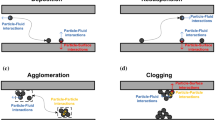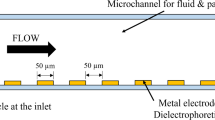Abstract
In this study, the irreversible deposition of microparticles from electrokinetic microfluidic flow in a 90° bend was examined both computationally and theoretically. The flow and electric fields were firstly simulated by the finite volume method, and then a large number of microparticles were injected and traced by the one-way coupling Lagrangian model, incorporating the electrical, hydrodynamic and near-wall repulsive forces exerted on the microparticles. The simulation results indicate that the microparticles with larger size are repelled to close to the upper region of the outer wall under the effect of dielectrophoresis (DEP) force, and the near-wall repulsive force which prevented particles from colliding with the wall would decrease the particles’ ultimate deposition efficiency. In addition, the specified exponential relationship between the particle deposition efficiency and its relaxation time or particle Stokes number are theoretically derived when the near-wall repulsive force is considered or not.
Similar content being viewed by others
References
WANG R., LIN J. Numerical analysis on a passive chaotic micromixer with helical microchannel[J]. Journal of Nanoscience and Nanotechnology, 2006, 6(1): 190–194.
ROS A. D. R., HELLMICH J. and REGTMEIER J. et al. Bioanalysis in structured microfluidic systems[J]. Electrophoresis, 2006, 27(13): 2651–2658.
KIM P., JEONG H. E. and KHADEMHOSSEINI A. et al. Fabrication of non-biofouling polyethylene glycol micro-and nanochannels by ultraviolet-assisted irreversible sealing[J]. Lab on a Chip, 2006, 6(11): 1432–1437.
KWAN H. K., XUAN X. and YUEJUN K. et al. Effects of DC-dielectrophoretic force on particle trajectories in microchannels[J]. Journal of Applied Physical, 2006, 99(6): 064702.
ZHENG L., BRODY J. P. and BURKE P. J. Electronic manipulation of DNA, proteins, and nanoparticles for potential circuit assembly[J]. Biosensors and Bioelectronics, 2004, 20(3): 606–619.
SHAIKH F. A., UGAZ V. M. Collection, focusing and metering of DNA in microchannels using addressable electrode arrays for portable low-power bioanalysis[J]. Proceedings of the National Academy of Sciences, 2006, 103(13): 4825–4830.
XIONG X., BUSNAINA A. and SELVAPRABA S. et al. Directed assembly of gold nanoparticle nanowires and networks for nanodevices[J]. Applied Physics Letters, 2007, 91(6): 063101.
YU M. Z., LIN J. Z. and CHAN T. L. Effect of precursor loading on non-spherical TiO2 nanoparticle synthesis in a diffusion flame reactor[J]. Chemical Engineering Science, 2008, 63(9): 2317–2329.
WANG J., RICHARD C. and JOHN H. Seinfeld. Diffusional losses in particle sampling systems containing bends and elbows[J]. Journal of Aerosol Science, 2002, 33(6): 843–857.
ZHANG Xiao-xi, CHENG Yong-guang. Simulation of hydraulic transients in hydropower systems using the 1-D-3-D coupling approach[J]. Journal of Hydrodynamics, 2012, 24(4): 595–604.
HARIKRISHNAN N. U., CHUN Y. Colloidal particle deposition from electrokinetic flow in a microfluidic channel[J]. Electrophoresis, 2009, 30(5): 732–741.
KANG Y., LI D. and KALAMS S. A. et al. DC-dielectrophoretic separation of biological cells by size[J]. Biomed Microdevices, 2008, 10(2): 243–249.
IRENA B. N., XUAN X. C. and LEEA J. S. H. et al. DC-dielectrophoretic separation of microparticles using an oil droplet obstacle[J]. Lab on a Chip, 2006, 6(2): 274–279.
YU M., LIN J. Taylor-expansion moment method for agglomerate coagulation due to Brownian motion in the entire size regime[J]. Journal of Aerosol Science, 2009, 40(6): 549–562.
NIE D., LIN J. A fluctuating lattice-Boltzmann model for direct numerical simulation of particle Brownian motion[J]. Particuology, 2009, 7(6): 501–506.
Author information
Authors and Affiliations
Corresponding author
Additional information
Project supported by the National Natural Science Foundation of China (Grant No. 10902105), the Natural Science Foundation of Zhejiang Province (Grant No. 2010R10014).
Biography: ZHANG Kai (1979-), Male, Ph. D., Associate Professor
Rights and permissions
About this article
Cite this article
Zhang, K., Xing, Yh., Tian, Fz. et al. Micropaticle transport and deposition from electrokinetic microflow in a 90° bend. J Hydrodyn 25, 535–541 (2013). https://doi.org/10.1016/S1001-6058(11)60393-5
Received:
Revised:
Published:
Issue Date:
DOI: https://doi.org/10.1016/S1001-6058(11)60393-5




